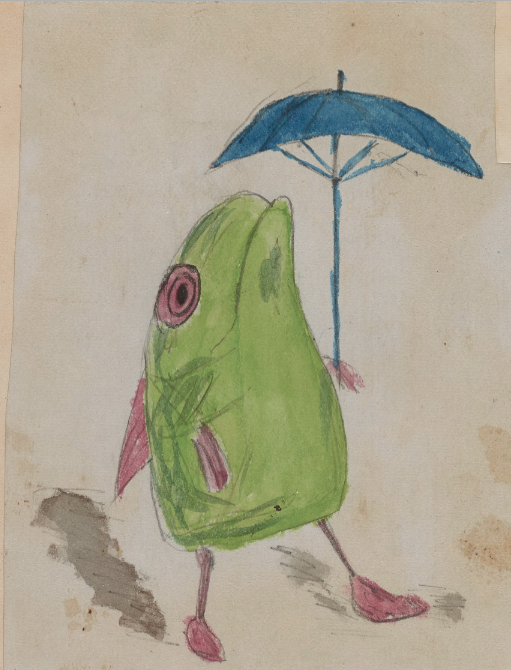I’ve written about my admiration of Charles Darwin as a husband and father, and the way he defied stereotypes of both Romantic Genius (which holds that really talented men are almost obliged by their devotion to work to be terrible spouses and parents) and the Victorian stereotype of the distant father. There’s lots of hagiography around Darwin, but there’s also plenty of documentary evidence that gives us a picture of him as a Good Dad.
Another data-point that came to my attention recently, via Open Culture: drawings by his kids on manuscript pages of his books and articles, now online thanks to the American Museum of Natural History’s Darwin Manuscript Project.

via Fish With Legs, via Open Culture
As writer Ted Mills notes in Open Culture, “the drawings show a Darwin who was a family man and not a reclusive scientist.”
As the AMNH Web site explains,
Darwin’s young children sometimes painted pictures and wrote stories on the back of draft manuscripts for Darwin’s books & notes. These drawings & stories were precious to the Darwin family. So it was thanks to the fortunate meeting of the children’s play with their father’s science that these extremely rare manuscripts of the Origin of Species (4 pages), Origin Portfolios type notes (2 notes), Cirripedia (9 pages), Orchids (1 page) were preserved. Otherwise, these items, precious to scholars, would have most likely been destroyed. Moreover, the four Origin pages are part of the only 45 Origin pages (plus 9 insert slips) that are extant–out of the original c. 600 page draft. The 9 surviving Cirripedia pages (8 fragments and 1 full page) are the sole survivors of that massive work. However, most often the children simply used their father’s writing paper–without his writing–to produce their pictures and their tales. We present here the totality of 111 images, which includes 94 images produced by the children and 17 images with drafts or notes in Darwin’s handwriting.
The New Yorker also had a short piece about the drawings:
What may seem like sacrilege now—turning the only handwritten copy of a seminal work of science into scratch paper—appears to have been normal then. Once Darwin had sent a fair copy of the manuscript off to his publisher, John Murray, he made the rest of his changes to the book directly on the galley proofs, and evidently he wasn’t precious about the originals. Paper being a hot commodity, the children co-opted the pages for themselves. Kohn doesn’t know for certain which kids were the artists, but he guesses that at least three were involved: Francis, who became a botanist; George, who became an astronomer and mathematician; and Horace, who became an engineer. The drawings are lively and full of color, made in pencil, ink, and watercolor, depicting real and imagined worlds, always with a Darwinian eye for detail. Part of the joy of these images, of course, is what they imply about Darwin—not the stereotype of a tortured, isolated great thinker but the abettor of scientific curiosity in others as much as in himself. Indeed, he often put his children to work on his research. “The kids were used as volunteers—to collect butterflies, insects, and moths, and to make observations on plants in the fields around town,” Kohn said.